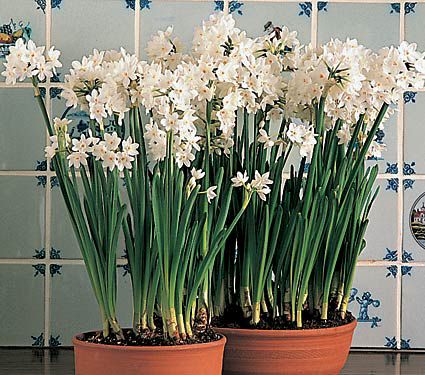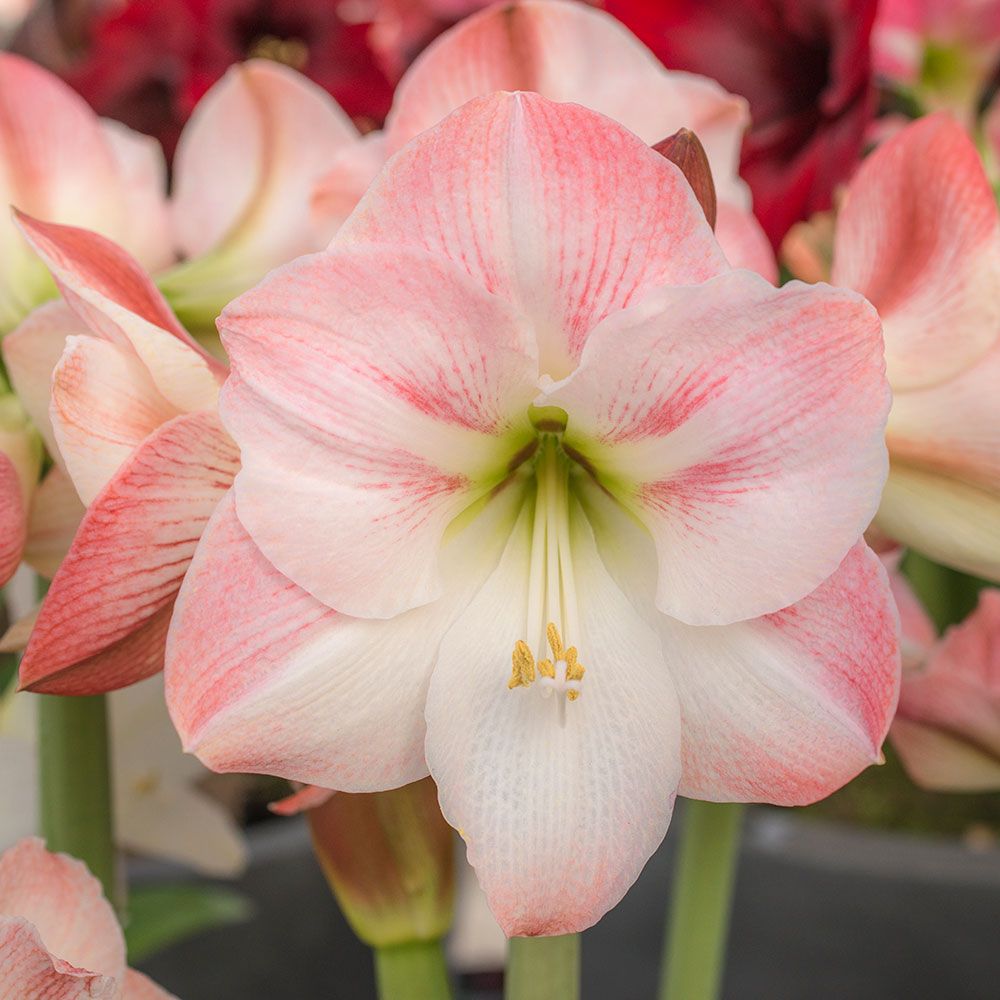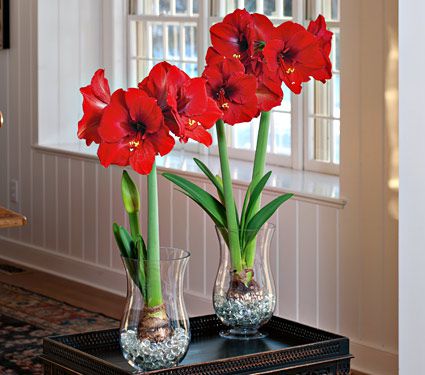
Welcome to Gardens By Danielle's blog! The blog will provide readers with tips and tricks for all things garden related, as well as give timely tips once a month. We hope you enjoy it!
Timely Tips...
In the Philadelphia area, its time to start putting your garden to bed for the winter. This means pulling up annuals and cutting back perennials to the ground. The annuals and perennials will die back in the next couple of weeks after we start getting hard frosts. Some people prefer to leave the perennials until the spring and then cut back the old, dead growth then. You'll also want to spread leaves or compost over your vegetable garden and other garden beds. Some people prefer to put mulch down instead, but this is not completely necessary.
This month, its also time to start forcing flower bulbs indoors. Some of the most popular bulbs for forcing indoors are Paperwhites and Amaryllis. When started now, they will bloom in time for the holidays. Some people also like to force spring blooming bulbs like, Daffodils, Tulips, Hyacinths, Crocus, and Iris indoors also. Spring blooming bulbs need to be pre-chilled for several weeks before being forced indoors. This fools the plant into thinking its spring, so it will then bloom indoors during the winter. These bulbs can then be planted outside in the spring.
Paperwhites and Amaryllis don't require pre-chilling since they are tropical. Paperwhites are tall and thin with lots of small, white, daffodil-like flowers that are fragrant. Amaryllis have 1-2 stalks with 4 large flowers per stalk. They come in orange, pink, red, white and bicolors. Amaryllis and Paperwhite both need to be staked when they get tall or they can tip or lean over. Paperwhites bloom 4-6 weeks after being planted and Amaryllis bloom in 8-10 weeks after planting.
Paperwhites can be planted in soil or in a vase in fine river stones or gravel. They need to be planted with their crowns exposed if planted in gravel. Place them in a sunny window and water whenever the soil dries out. If the Paperwhites are planted in gravel, keep the water level up to the bottom of the bulbs.
Paperwhites (Photo Courtesy of White Flower Farm)
Amaryllis can also be planted in soil or river gravel. When Amaryllis are planted in soil or river stones, they should only be buried with their crowns and 1/4 from the top of the crown exposed. Some of my favorite cultivars are 'Apple Blossom' and 'Ferrari.' 'Apple Blossom' has blooms that are a light pink and white. 'Ferrari' has bright cherry red blooms. Amaryllis should only be watered when they dry out almost completely when planted in soil and the water level should be maintained right under the surface of the stones when grown in stones. Don't overwater or the bulbs will rot. Amaryllis bulbs will re-bloom next year if treated in a certain manner after blooming or you can start with new bulbs every year.
Amaryllis 'Apple Blossom' (Photo Courtesy of: White Flower Farm)
Amaryllis 'Ferrari' (Photo Courtesy of: White Flower Farm)
I hope these tips help to bring some color and beauty during the dark, grey days of winter.
Timely Tips...
Its that time of year again to start seeds for the spring! In order to have vegetable, herb, annual and perennial seedlings ready to plant in time, you need to plant them now. Here are some benefits of starting plants from seed:
You have more varieties to choose from
It costs less to start seeds than to buy already started plants
You can be sure that your herbs and vegetables are grown organically right from the start
Its fun! Its the perfect educational project for children!
Vegetables:
Cooler weather vegetables or vegetables that prefer growing in cooler weather like during spring and fall benefit from getting a head start indoors. These plants are usually planted outside in the garden in early to mid March in the Philadelphia area. Cooler weather vegetables include:
lettuce- leaf and head
broccoli
spinach
carrots
radishes
beets
peas
cauliflower
cabbage
kale
If you like, these can be direct seeded out in the garden in early to mid March, but may need protection if it goes down to freezing at night. (I'll talk more about that in the next Timely Tips in March). These seeds need to be started now. Successive sowing every 2-3 weeks can help to ensure you get a regular harvest.
Warm weather vegetables are those that prefer warmer temperatures and are planted after the danger of frost, which is usually the end of April or beginning of May in this area. Warm weather vegetables include:
Tomatoes
Peppers
Eggplant
Green Beans
Cucumber
Squash
Zucchini
Okra
Seeds of these vegetables also benefit from being started indoors before the last frost. Tomatoes, peppers and eggplant need to be started about 6-8 weeks before the last frost date. Green beans can be directly seeded. Cucumber, squash, and zucchini can be started 2-4 weeks before the last frost date, since they grow faster. These can also be directly seeded in the ground. Remember to harden off all seedlings before planting them in the garden. (I'll talk more about this in the next issue of Timely Tips). For these seeds, wait a couple more weeks before starting them. A good rule of thumb is to count backwards from the last frost date for your area.
Herbs:
Most herb seedlings also benefit from being started indoors also. Here is a list of herbs that should be started indoors:
Basil
Parsley
Sage
Chives
Thyme
Oregano
Lavender
Sweet Marjoram
Lemon Balm
Herb seeds need to be started now, since they need at least 10-12 weeks to develop into nice sized starts before being planted outside after the danger of frost.
Flowers:
A lot of flower seeds need to be started indoors also. Annuals that need at least 10-12 weeks to develop before the last frost date include: pansies, petunias, impatiens, and snapdragons. Annuals that need 4-6 weeks to grow indoors before the last frost include: marigolds, nasturtiums, four o'clocks, and sunflowers. Be sure to look at the germination time on the backs of the packets of seed and take the germination time into consideration when deciding when to start the seeds indoors also. Perennial seeds also benefit from being started indoors.
Tips for starting seeds indoors:
Container: Be sure to use seed starting trays with drainage in the bottom.
Soil: Any soil that is used for germinating seeds needs to be well draining, light in weight and loose. Don't use soil from outside. I like to use soil less mixtures like Pro-Mix and Organic Mechanics.
Light: Some seedlings need light to germinate and others need darkness to germinate, be sure to refer to the back of the seed packet for details. Once they are germinated, most seedlings require a good bit of light. To achieve this, you can either put them in a sunny east, west or south facing window or in a sunroom, if you are fortunate enough to have one. If you don't have a sunny enough window, you can use supplemental lighting like fluorescent lights. You can either buy shop lights fixtures at your local hardware store and set up your own light stand or you can buy a plant light stand with multiple shelves and lights on a rolling cart. Be sure to get fluorescent bulbs that are either "full spectrum" or "daylight"- 65,000 K. These bulbs mimic natural sunlight as much as possible. In order to get good results, the lights must be positioned 2" above the tops of the plants. This will prevent the plants from getting leggy and reaching for the light. If the seedlings are in the windowsill, remember to rotate them often, so that they grow straight. The lights will need to be on for 10-12 hours a day. A good way to accomplish this is with a timer.
Water/Humidity: Germinating seeds need a moist, but not soggy growing medium. They also require somewhat high humidity. When you plant your seeds, place the trays in a shallow container of water, so that they wick up the water through their drainage holes until the growing medium is evenly moist, but not soggy. Or you can mist the surface of the soil lightly, as long as the seeds are buried under the soil so they don't go flying when you mist them. If they are surface planted, bottom watering is better. To keep the seed trays from drying out and to keep the humidity level moderately high, cover them with plastic domes available at your local garden center. Remember to remove the plastic cover when the seeds germinate.
Temperature: Seeds require temperatures ranging from 68-75 degrees Fahrenheit to germinate. The warmer it is, the quicker they germinate. Most of the time, normal room temperature (68-72 degrees Fahrenheit) is fine. Also, fluorescent lights put off some heat, too. If you keep your house cooler, than you may need a seedling heat mat. These are rubber mats that get placed below the seed trays and heat the soil to around 70-74 degrees Fahrenheit.
Fertilizing: Be sure to fertilize your seedlings 2-3 weeks after they germinate. You should fertilize every other or every third watering. I like to use organic fertilizers like Neptune's Harvest, Plant Tone or Vegetable Tone.
Stay tuned for the March issue of Timely Tips! Happy Gardening!
Sources for seeds, seed starting supplies, and equipment:
Local: Primex Garden Center, Glenside, PA www.primexgardencenter.com
Mail Order: Johnny's Selected Seeds http://www.johnnyseeds.com/ , Select Seeds http://www.selectseeds.com/ , Burpee Seed Co. http://www.burpee.com/ , J.W. Jung Seed http://www.jungseed.com/ , Seed Savers Exchange http://www.seedsavers.org/





